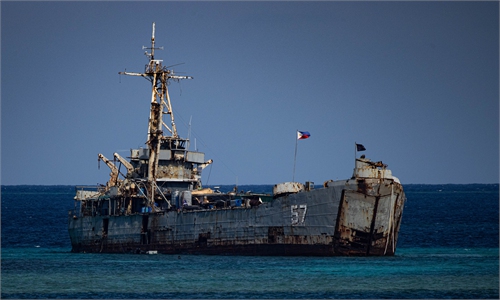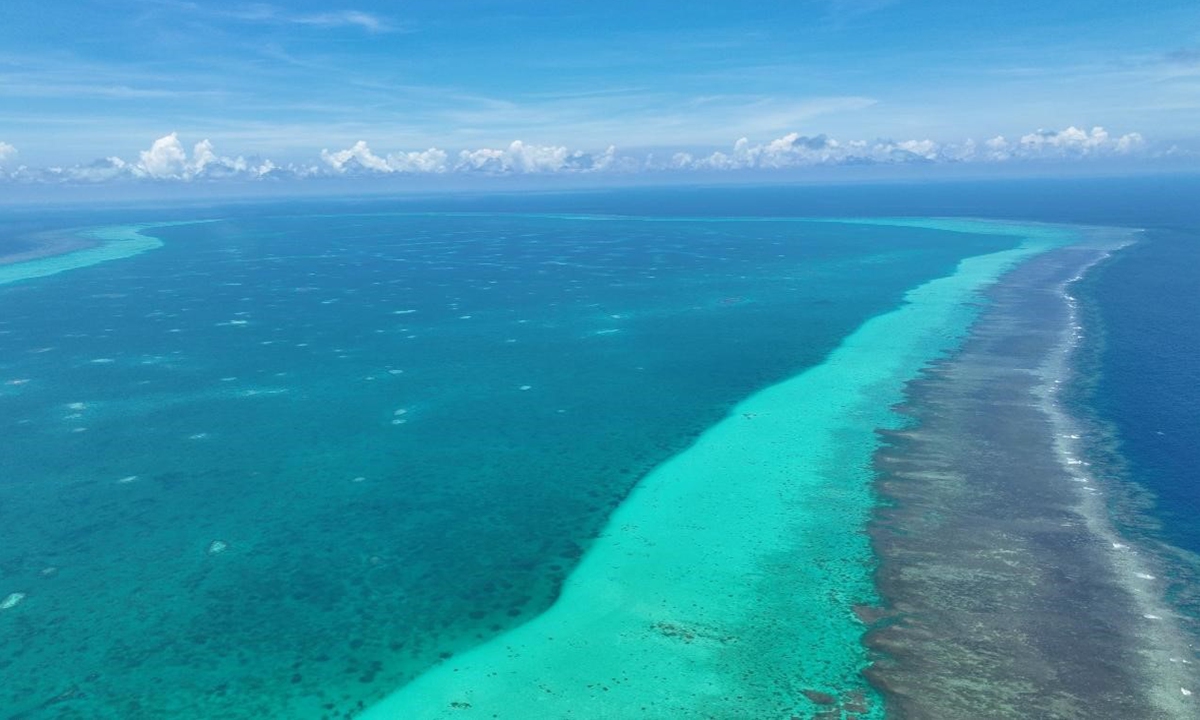
The aerial view of China's Huangyan Dao Photo: Courtesy of South China Institute of Environmental Sciences under China Ministry of Ecology and Environment
China on Wednesday released the first investigative and assessment report on the ecological environment near Huangyan Dao (also known as Huangyan Island) in South China Sea, revealing that the area enjoys excellent eco-environmental quality.
As the Philippines accused Chinese fishermen of destroying coral reefs around Huangyan Dao due to "illegal actions such as harvesting endangered giant clams" in May, Chinese experts believe that Manila's move to shift blame to China in an attempt to pursue a new legal battle is doomed to be futile in light of the evidence and facts revealed in the report.
From May to June, Chinese scientific researchers carried out an unprecedentedly large-scale on-site investigation to assess the ecological and environmental conditions in the Huangyan Dao area. This included evaluating seawater quality, marine sediment quality, biological quality, floating litter, as well as coral communities, reef-dwelling fish, and other typical biological groups, with the assistance of satellite remote sensing analysis.
The results of the research revealed a good seawater and marine sediment quality, which was below-standard levels of pollutants, zero cyanide detected of seawater samples, an abundant distribution of giant clams, and a healthy state of the coral reef ecosystem.
Experts noted that this scientific research shows that China's effective governance of Huangyan Dao has played a positive role in protecting the island's ecological environment.
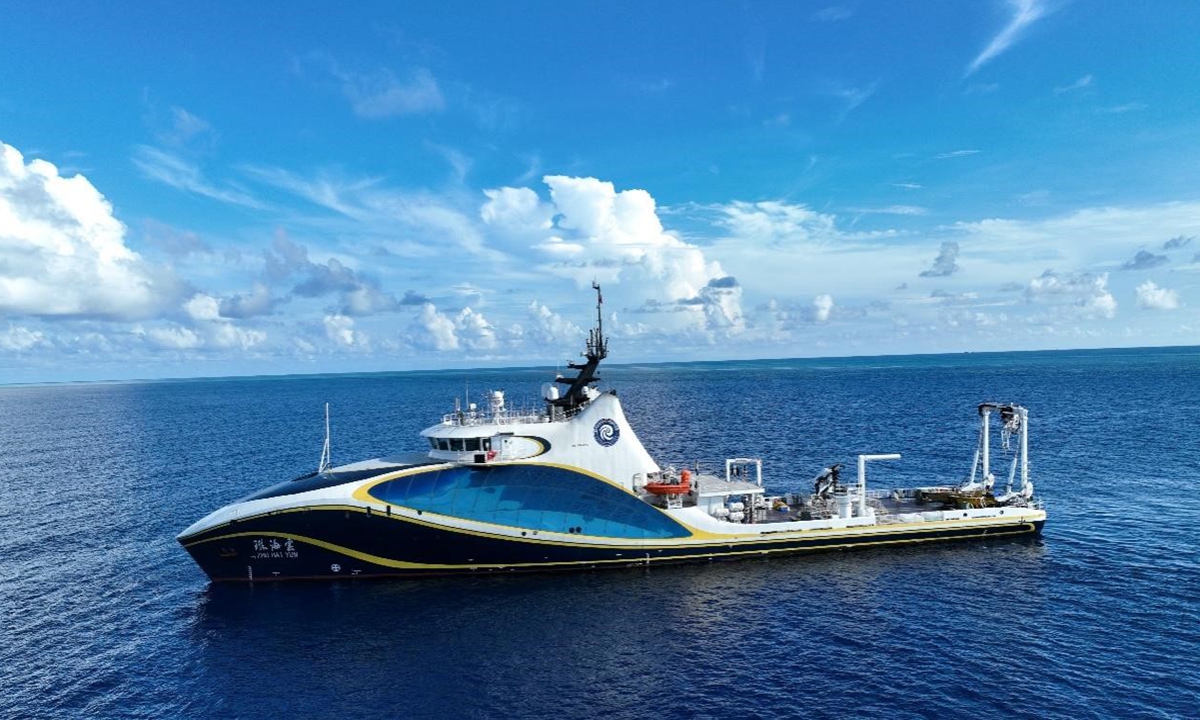
The scientific research ship in China's Huangyan Dao area Photo: Courtesy of South China Institute of Environmental Sciences under China Ministry of Ecology and Environment
A harbor of coralsHuangyan Dao located in the southeast of Zhongsha Qundao, serving as a key traditional fishing area and natural shelter in China. It is also a vital "harbor" for maintaining marine biodiversity in the South China Sea, holding substantial strategic and ecological significance.
Since last year, some Philippine politicians and media have repeatedly hyped up the topic of falsely claiming that Chinese fishermen used cyanide to fish in waters off Huangyan Dao and deliberately destroyed the traditional fishing grounds of Philippine fishermen.
However, according to the report, no cyanide, copper, lead, cadmium, total chromium, mercury, or arsenic were detected at any survey sites.
In response to Global Times' question on whether it means there was no cyanide fishing in the area, Lin Kui, the deputy director of South China Institute of Environmental Sciences under China Ministry of Ecology and Environment, confirmed the conclusion.
During the more than 20 days of scientific research, the joint investigation team did not find fishermen illegally using cyanide for fishing, Lin stressed. He also cited published academic paper that Filipino fishermen have used cyanide to poison fish since 1930s, and even during the global pandemic years, there were still reports of Filipino fishermen using cyanide to poison fish at sea.
"We sincerely hope that countries around the South China Sea can stop using cyanide for fishing and other destructive fishing activities, and work together to protect the fragile ecosystem of the South China Sea," Lin said.
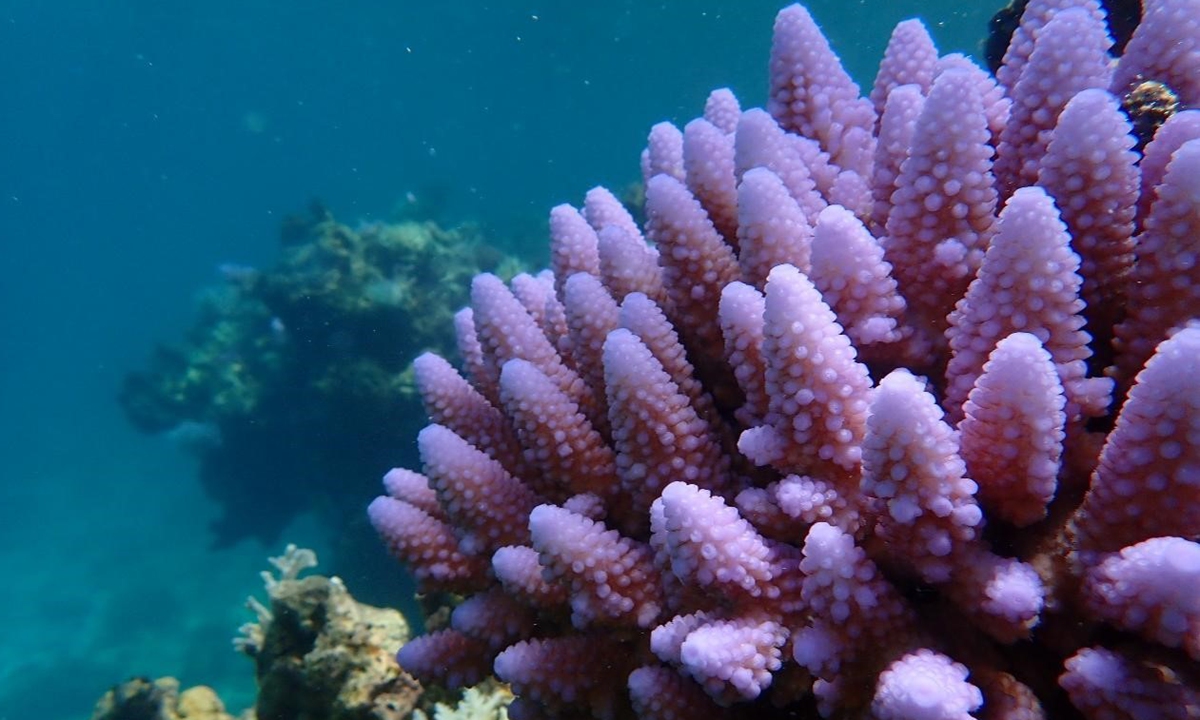
Live coral reefs in the lagoon of Huangyan Dao Photo: Courtesy of South China Institute of Environmental Sciences under China Ministry of Ecology and Environment
Results also show that it meets the water quality requirements for coral growth in the South China Sea. There are also no signs of seawater eutrophication.The hard coral communities were in healthy condition, while live coral cover in the northeast part of Huangyan Dao reached as high as 37.1 percent. This is comparable to the Great Barrier Reef in Australia that contains the world's largest collection of coral reefs, the report showed.
The scientific research recorded 109 species of hard corals belonging to 34 genera and 12 families, marking the highest species diversity ever documented. The average hard coral cover reached 28.6 percent, higher than the survey results in 2015, with sufficient recruitment of juvenile corals.
All the hard coral species were listed as national Class II protected wildlife in China. Among the hard corals in this survey, 41 species were classified as Near Threatened and 14 species as Vulnerable in the International Union for Conservation of Nature's Red List of Threatened Species (IUCN Red List).
The species diversity of coral communities was relatively high, as the survey recorded 125 species of coral reef fish from 23 families on-site.
International scholars generally believe that global warming is the major reason behind the rapid degradation of coral reefs (coral bleaching) on a global scale. But hard coral communities near Huangyan Dao demonstrate strong resistance and a tolerance to rising sea temperatures, making the island a healthy habitat for corals and related species in the South China Sea.
According to the survey results, the bleaching of hard corals in Huangyan Dao remained at a low level (below 1 percent). No coral disease was identified, and the coral mortality rates also remain low (below 1 percent).
Since China began to exercise long-term effective administrative jurisdiction over Huangyan Dao, it has gradually repaired the marine pollution and ecological damage caused by previous destructive fishing by the Philippines in the area, Yang Xiao, deputy director of the Institute of Maritime Strategy Studies under the China Institute of Contemporary International Relations, told the Global Times.
He noted that Huangyan Dao used to be a target range for the US military, and the coral reefs there have also been severely damaged by the remnants of shells for a long time.
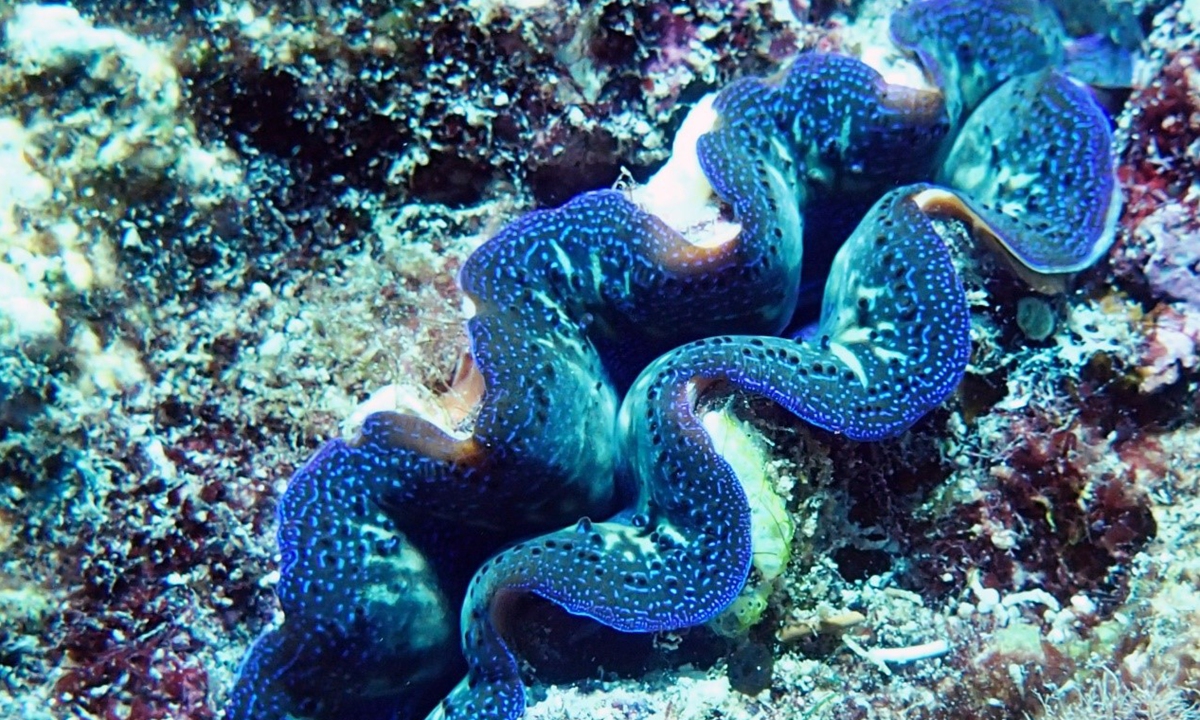
A giant clam discovered in Huangyan Dao area Photo: Courtesy of South China Institute of Environmental Sciences under China Ministry of Ecology and Environment
It is worth noting that this survey revealed a rich distribution of giant clams in the lagoon of Huangyan Dao. Giant clams, the largest marine bivalve inhabiting coral reefs, is listed as key protected wildlife in China and is included in the IUCN Red List. The giant clams, as a reef-building organism, contributes to the formation and stabilization of coral reef frameworks, which is essential for the support of coral reef development and the maintenance of a balanced ecosystemLin told the Global Times that since 2016, China has explicitly banned the sale and purchase of giant clams and their products. This regulation has been strictly enforced, and based on on-site observations, it is no longer possible for illegal digging and harvesting of giant clams to occur on Huangyan Island.
The survey also recorded blue coral, fire coral, sea anemone, soft coral and other coral reef ecological communities. These organisms are not only an important component of reef biodiversity, but also a hot resource of the latest marine natural products and marine medicine. With diverse bioactive compounds, they have great potentials in the development of new drugs, cosmetics and healthy food.
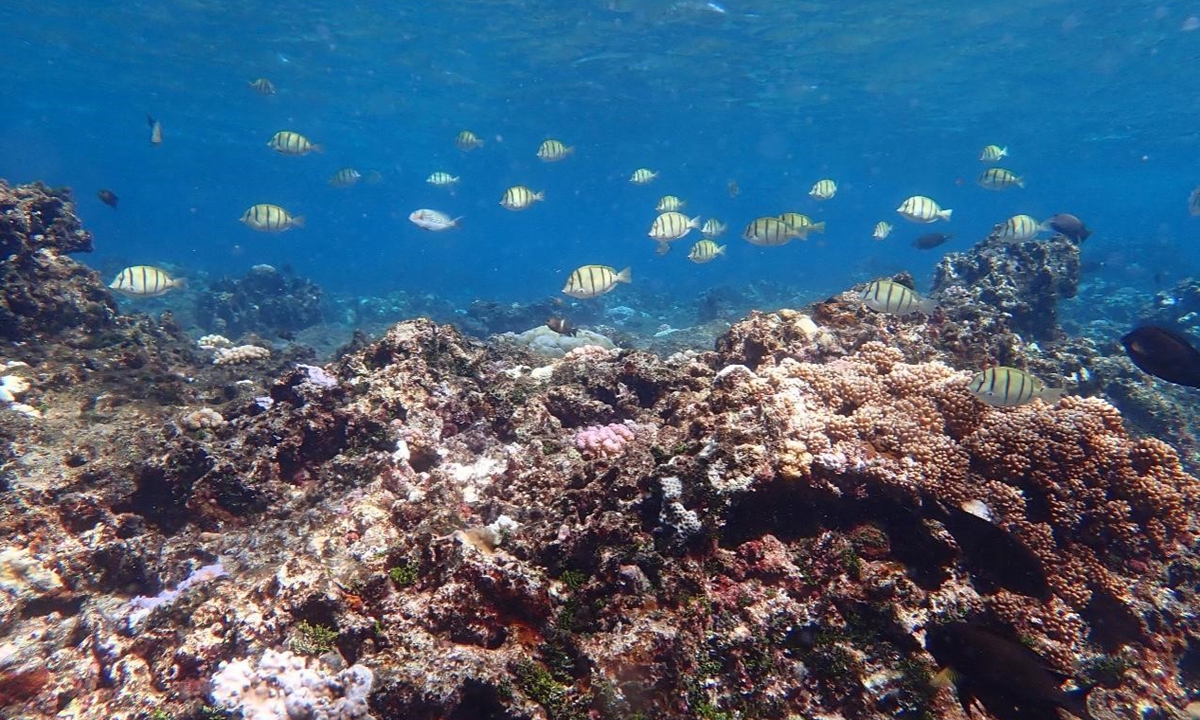
Coral reefs and abundant fishes in Huangyan Dao area Photo: Courtesy of South China Institute of Environmental Sciences under China Ministry of Ecology and Environment
Groundless accusationIn recent years, for promoting the scientific conservation and long-term sustainable use of global fishery resources, China has set a model for global marine ecological preservation through innovative measures, including strict annual fishing moratorium policies in its territorial waters.
The South China Sea summer fishing moratorium system, which was officially implemented in China since 1999, has been in effect for 25 years. This system not only demonstrates the Chinese government's commitment to protecting marine fishery resources, but also showcases China as a responsible global leader in safeguarding the marine ecological environment and promoting sustainable fisheries development.
However, China's efforts are not always understood. The Philippines and the US have consistently promoted negative narratives targeting China, leveling accusations of environmental destruction in the South China Sea and hinting at possible court action against the country.
In February, the Philippines claimed that Chinese fishermen were using cyanide at Huangyan Dao. However, Chinese marine experts have pointed out that the Philippines has, in fact, been using cyanide for fishing since 1962, and approximately 65 tons of cyanide are sprayed onto coral reefs each year, according to World Wildlife Fund. This severely damaged the marine ecology of the South China Sea.
Additionally, in 2023, the Center for Strategic and International Studies (CSIS) issued a report titled "Environmental Threats to the South China Sea." In the report, the Center claims that "increased fishing, dredging, and land fill, along with giant clam harvesting in recent decades have taken a devastating toll on thousands of species found nowhere else on earth."
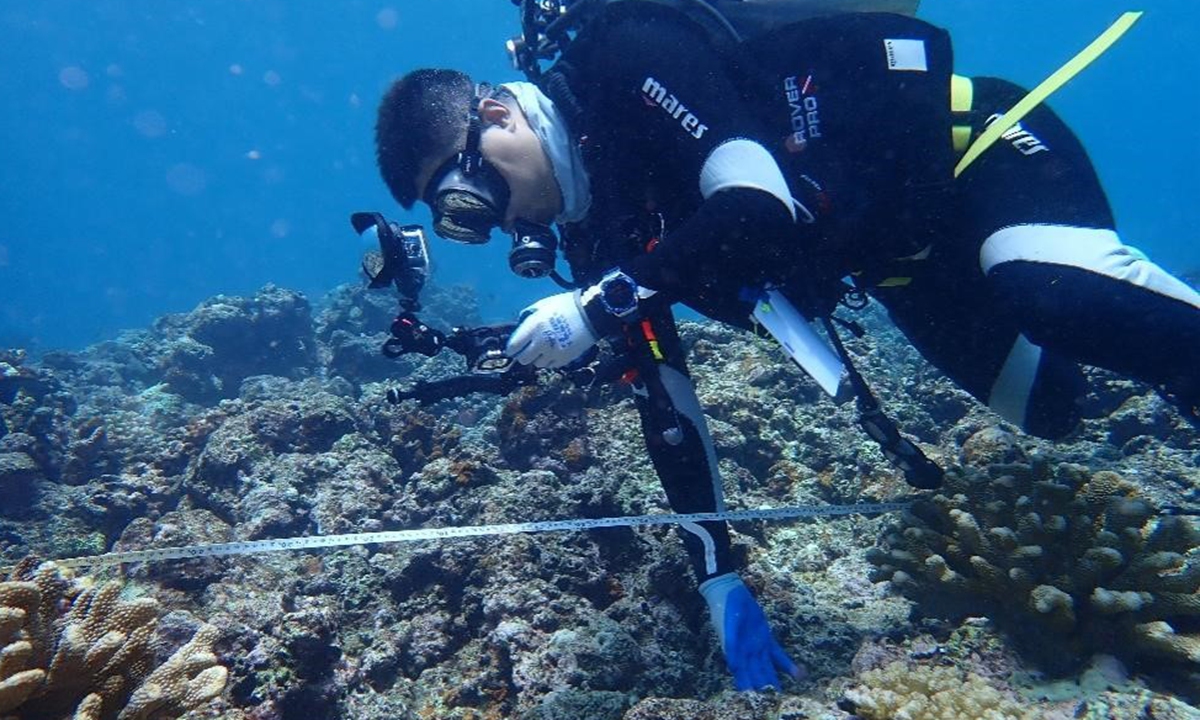
A Chinese researcher dives into the seabed to detect the ecosystem condition around Huangyan Dao. Photo: Courtesy of South China Institute of Environmental Sciences under China Ministry of Ecology and Environment
According to scholars who are directly engaged in ecological surveys and research in the South China Sea, many conclusions in this report are based on little to no scientific proof."Only on-site scientific investigations with facts are worthy of respect. This scientific report provides a strong rebuttal to the Philippines' proposed environmental arbitration against China. In the face of facts, the Philippines' futile attempts are doomed to fail," said Yang.

